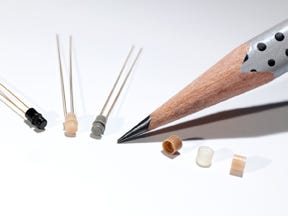Material supplier tunes in to its
customer on hearing aid project
Knowles Electronics wasn’t a dream customer for resin suppliers with its small quantities and tight specifications, but one company took it on and helped make the product a success.
April 21, 2010
Knowles Electronics wasn’t a dream customer for resin suppliers with its small quantities and tight specifications, but one company took it on and helped make the product a success.
There is precious little margin for error when you are molding parts that are smaller than a single pellet of material. There’s even less when the material is 50% glass-filled nylon, wall thicknesses are 0.010 inch and often smaller, and you need to match more than 60 colors, including 20 different flesh tones. That’s exactly the challenge faced by Knowles Electronics, a leading manufacturer of miniature audio components for hearing-aid manufacturers around the world. Providing the solution were Accumold LLC (Ankeny, IA), the micromolder that actually makes the parts, and the Clariant Masterbatches specialty compounding unit, which supplied the custom-compounded, glass-filled material.
|
“Our customers include almost all of the major hearing-aid manufacturers,” says Bob Walter, global commodities manager for Knowles, which is headquartered in Itasca, IL. “They are very specific about the color of the parts we sell them. If it can be seen by the customer, there are very exact color specifications and we have to match that color standard time after time, which isn’t always easy.”
The other issue, notes Tom Murphy, VP of production at Accumold, is the fact that they need so little of any particular color. “With components this small, 100 lb will yield more than 50,000 parts. There are not a lot of companies who are willing to work with us on these small quantities, but Clariant will and we can really rely on them to repeat the colors accurately from lot to lot.”
Clariant supplies Knowles and Accumold with nylon 6/6 at three different levels of glass fiber: 50%, 35%, and 30%. Even in parts as tiny as those Knowles requires, the glass is needed to provide stiffness and dimensional stability. Clariant delivers these materials in customer-specified colors—even technically difficult shades—and builds in additives that can improve processing and end-product performance.
The nylon supplied for Knowles parts, for instance, is specially formulated for improved flow so that it more easily fills the tiny mold sections. Clariant maintains an inventory of the materials that Accumold and Knowles use most commonly, so they can ship next day if necessary. For lower-volume compounds, natural resin is inventoried so it can be compounded and shipped rapidly.
Under control
Accumold’s Murphy says they really value Clariant’s ability to meet their tight specifications. “The color dispersion needs to be so precise,” he explains. “In the parts we mold there is a definite transparency factor. If you evaluate a 2- or 3-inch sample chip, the color might look just fine, but in these thin wall sections, you can immediately see any inconsistency. The other thing we worry about is black specks.”
An occasional byproduct of the compounding process, the black specks Murphy refers to are tiny bits of polymer that get hung up in the extruder. They degrade and break free, and appear in the finished compound. Some can be seen by the naked eye and others are microscopic. “If you can see it in the finished part,” he says, “the customer will reject it. It was a big problem with other vendors but Clariant seems to have gotten it under control.”
Clariant Masterbatches has established formulations based on standardized raw materials (resin, glass, pigment, stabilizers, and so on) and has instituted tightly controlled manufacturing processes to limit contamination. According to Bob Wick, Clariant Masterbatches product manager, specialty compounding, “We use a testing procedure developed by TAPPI, the pulp and paper industry association, to measure exactly how many and what size specks are in a given sample. It’s one thing to say you have no black specks and quite another to certify it on a lot-to-lot basis, but that’s what we have done for the materials we produce for Knowles.”
Bob Walter and Tom Murphy acknowledge that other companies have tried to compete for their business but, ultimately, they all shied away from it because of the strict specifications and the small quantities involved. Bob Wick explains, “Clariant Masterbatches welcomed the challenge and we worked closely with Knowles to make sure that all their criteria could be met and that they could continue to be successful in this market. At the same time, we worked closely with Accumold to develop a very ‘molder-friendly’ compound, along with the quality and consistency they require.” —Contributed by Clariant 
Masterbatches, edited by 
IMM Staff
About the Author(s)
You May Also Like



